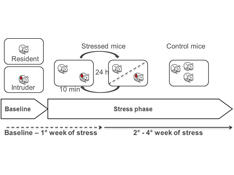A mouse model of Chronic Psychosocial Stress: Energetics, Obesity, Psychpathologies and Aging
Epidemiological evidence demonstrates that psychiatric and metabolic diseases are rising exponentially to pandemic level. A substantial number of obese individuals show eating disorders, psychiatric conditions, stressful life events, more medical complaints and poorer quality of life. Unfortunately, current animal models largely fail to recapitulate the vast array of symptoms which are observed in the obese human population.

We developed a unique mouse model of chronic psychosocial stress [1.2].
Briefly stable resident/intruder pairs of adult male mice are established after a baseline period. In the stress phase resident/intruder pairs live in the same cage separated by a perforated partition , which allows sensory but not physical contact and are allowed a brief daily physical interaction which lasted a maximum of 10 min. Subordinate and dominant mice are identified by direct observation.
Current projects:
-
Type 2 diabetes:We are investigating the molecular mechanism of subordination stress induced T2D. Subordinate mice develop a complex syndrome characterized by weight gain, features of the metabolic syndrome, glucose intolerance and insulin resistance (Sanghez et al, submitted).
-
Aging:We are investigating if stress, hyperphagia and nutrients partitioning will differentially affect ageing and result in accelerated mortality in dominant or subordinate mice. Supported by NIH Transformative Award R01. 1R01AG043972-01. Energetics, Disparities, & Lifespan: a unified hypotesis.
-
Adrenal clock:We will ask the question if chronic subordination stress will affect the period and phase of the adrenal clock gene system, corticosterone secretion from adrenal gland and if this affects individual vulnerability to stress-induced metabolic and psychiatric disorders. In collaboration with Prof. W. Engeland (UofM, Neuroscience). Supported by Wallin Neuroscience Discovery Awards 2012.
References: 1.Bartolomucci A, et al. Physiol Behav. 2001;73:401-10. 2.Bartolomucci et al., Neurosci Biobehav Rev. 2005;29:67-81.